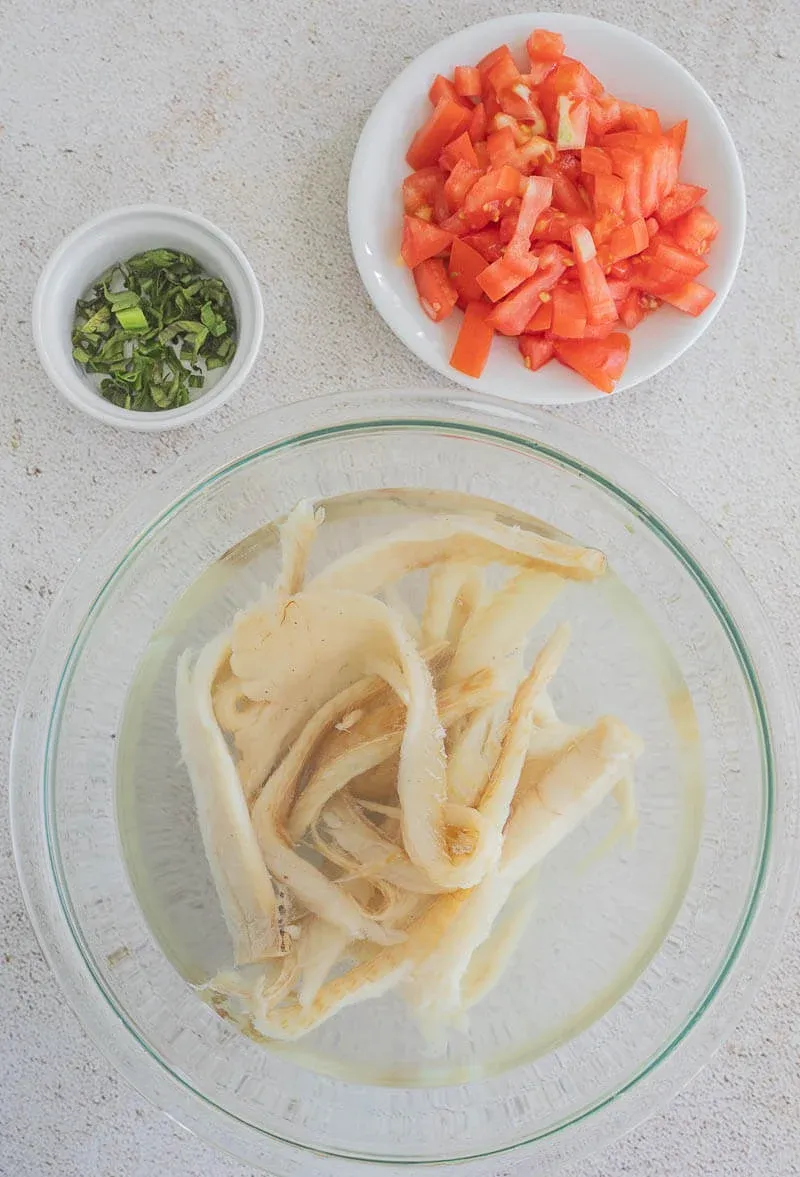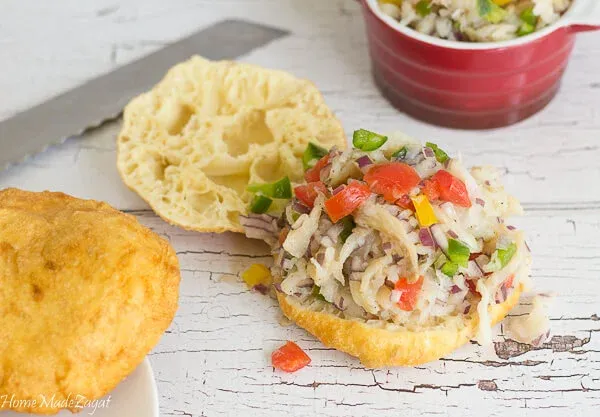Caribbean salt fish: What it is and how to cook with it
2.3.24
| Recipe by Renz
Curious about what is saltfish and its importance in Caribbean and African food?
Dive into this overview that covers the what, why, and various ways we use this
very popular meat.
Caribbean people love to eat a good saltfish dish. It's an integral part of the Caribbean food landscape.
Welcome to a journey through the savory world of Caribbean saltfish!
In this post, we'll delve into the rich history of this culinary staple, exploring its significance in Caribbean cuisine (it's even the essential ingredient of Jamaica's national dish). We will discover the traditional methods used to rehydrate this flavorful ingredient and unlock its culinary potential.
Whether you're a seasoned chef or a curious food enthusiast, we'll also share a variety of recipes for you to try and savor the unique taste of Caribbean saltfish.
Let's embark on a flavorful exploration together!
Caribbean salt fish, also known as bacalao, baccalà, or salted cod, has its origins in the Atlantic fishing trade. The most common types of salt fish include cod, haddock, and pollock, which are salted and dried to extend their shelf life.
It is important to note that most of the salt fish consumed in the Caribbean is imported from Canada and other North American countries due to the decline of local fishing industries.
This traditional method of preserving fish was brought to the Caribbean by European explorers and traders during the colonial era and has since become a staple in African and Caribbean cuisines.
In African and Caribbean cultures, salt fish is used in a variety of dishes, including stews, fritters, and fish cakes. It is often soaked in water for several hours or even with an overnight soak to rehydrate and remove the copious amounts of excess salt before being cooked. This versatile ingredient adds a rich, savory flavor to dishes and provides a convenient source of protein for communities with limited access to fresh fish.
Salt fish plays a significant role in traditional cuisine, symbolizing the fusion of European, African, and indigenous influences in the region's culinary traditions.
Saltfish has a long culinary history, with its roots in the preservation of salt cod. The practice of preserving fish in salt to remove moisture dates back to ancient times, when it was used as a way to prevent spoilage and ensure a stable food supply. This preservation method allowed fish to be stored for long periods without refrigeration, making it an important staple in many cultures around the world.
Today, saltfish is sourced directly from fishermen in Northern Norway, where it is carefully prepared and preserved using traditional methods. It is important to note that the saltfish sourced from this region is MSC (Marine Stewardship Council) certified for sustainability and quality, ensuring that the fishing practices are environmentally responsible and that the fish populations are being managed effectively.
The culinary connection of saltfish extends from its historical preservation methods to its modern-day sourcing and sustainability efforts. This makes saltfish not only a delicious and versatile ingredient but also a responsible choice for consumers who are mindful of the environment and the impact of their food choices.
The process of making the fish salted can be done in two ways. It's either the dry method or the brine method.
The key difference between the dry method and the brine method of salting fish lies in the salting process and the desired salt concentration. In the dry method, salt is rubbed directly onto the fish, allowing for better control over the salt concentration and resulting in a firmer texture.
On the other hand, the brine method involves soaking the fish in a saltwater solution, resulting in a more even distribution of salt but with a moister texture. The dry method also has the advantage of requiring less salt for the desired concentration compared to the brine method.
Preparing salt fish for cooking requires some simple yet important steps to ensure it's ready for your favorite recipe. From soaking the salt fish to removing any excess salt, these crucial steps can make all the difference in the final dish.
By following the steps below, you can effectively learn how to desalt and prepare salt fish for cooking and enjoy a delicious, flavorful meal.
The boiling method for preparing salted cod involves boiling the fish multiple times until the desired level of salt content is achieved. To start, the salted cod is rinsed to remove salt, then the fish is placed in a pot of fresh water and brought to a boil. After boiling for several minutes, the water is drained and replaced with fresh water. This process is repeated 2-3 times, or until the fish reaches the desired level of saltiness.
Once the salted cod is properly boiled, it can be shredded into small pieces and used in a variety of dishes, such as soups, stews, and salads.
The boiling method helps to remove excess salt from the fish, making it more palatable and versatile for cooking.
The soaking process involves placing the salted cod in a bowl or container and covering it with fresh cold water. It is important to change the water multiple times during the soaking process to achieve the desired level of saltiness. This helps to draw out the excess salt from the fish, making it more palatable for the final dish.
To start, rinse the salted cod under cold water to remove any surface salt. Then, place the fish in a bowl and cover it with cold water. Allow it to soak while changing the water every 40 minutes. You can also do overnight soaking with this method.
The number of times the water is changed will depend on the initial saltiness of the fish and personal preference. After the soaking process, the salted cod should be less salty and ready to be used in your saltfish dish.
In this process, you make sure you clean up the fish skin and remove any bones (if you have bone in). Chip the cod into pieces and then place a colander in the sink over a bowl of water.
Place the fish in the colander and with running cold water take your hand and massage the fish in the water like you are washing it. As the water gets filled in the bowl, throw off the water and keep "washing".
Again, the amount of time you would need to change the water and continue with this process would depend on the fish's saltiness and your personal salt tolerance.
If you are looking to purchase salt fish, several varieties are available. The most common varieties are bone-in with skin intact, boneless with skin removed, and flaked in a can.
Bone-in salt fish, with the skin intact, is generally the least expensive variety, as it requires more preparation before cooking. Boneless salt fish, with the skin removed, is typically a bit more expensive due to the additional processing. Flaked saltfish in a can is the most convenient but also the most expensive option.
When purchasing bone-in salt fish, it will need to be soaked for at least 24 hours, with frequent water changes, to remove the excess salt before cooking.
Typical package sizes for household use range from 8-16 ounces, with bone-in and boneless salt fish generally being sold in vacuum-sealed packages, and flaked saltfish being sold in cans.
When purchasing salt fish, it's important to consider the variety, cost, and preparation process to choose the best option for your needs. My go-to is boneless with the vacuum-sealed packages.
Now that you have your saltfish, we are ready to get it cooked up.
At the most basic level, you can easily cook some salted fish in coconut oil with hot pepper, fresh thyme, spring onions, bell peppers, and lots of onions. But if you want a fancier saltfish recipe check out the ones below.
Some great breakfast options are saltfish buljol or the traditional Jamaican dish of Jamaican ackee and salt fish where they cook up the fish with fresh ackee fruit which is the national fruit of Jamaica.
If you are interested in making a snack with some saltfish, then try making some fish cakes: Trinidad accra or Jamaican saltfish fritters. Saltfish pies are also a favorite.
Some great lunch options would be:
No matter which method you choose, there are endless ways to enjoy saltfish in your cooking. With its unique flavor and versatile nature, it is a great addition to any meal. Whether you're boiling, frying, steaming, or baking it, you're sure to create a delicious and satisfying dish.
Caribbean people love to eat a good saltfish dish. It's an integral part of the Caribbean food landscape.
Welcome to a journey through the savory world of Caribbean saltfish!
In this post, we'll delve into the rich history of this culinary staple, exploring its significance in Caribbean cuisine (it's even the essential ingredient of Jamaica's national dish). We will discover the traditional methods used to rehydrate this flavorful ingredient and unlock its culinary potential.
Whether you're a seasoned chef or a curious food enthusiast, we'll also share a variety of recipes for you to try and savor the unique taste of Caribbean saltfish.
Let's embark on a flavorful exploration together!
What is salt fish in the Caribbean?
Caribbean salt fish, also known as bacalao, baccalà, or salted cod, has its origins in the Atlantic fishing trade. The most common types of salt fish include cod, haddock, and pollock, which are salted and dried to extend their shelf life.
It is important to note that most of the salt fish consumed in the Caribbean is imported from Canada and other North American countries due to the decline of local fishing industries.
This traditional method of preserving fish was brought to the Caribbean by European explorers and traders during the colonial era and has since become a staple in African and Caribbean cuisines.
In African and Caribbean cultures, salt fish is used in a variety of dishes, including stews, fritters, and fish cakes. It is often soaked in water for several hours or even with an overnight soak to rehydrate and remove the copious amounts of excess salt before being cooked. This versatile ingredient adds a rich, savory flavor to dishes and provides a convenient source of protein for communities with limited access to fresh fish.
Salt fish plays a significant role in traditional cuisine, symbolizing the fusion of European, African, and indigenous influences in the region's culinary traditions.
History of Saltfish
Saltfish has a long culinary history, with its roots in the preservation of salt cod. The practice of preserving fish in salt to remove moisture dates back to ancient times, when it was used as a way to prevent spoilage and ensure a stable food supply. This preservation method allowed fish to be stored for long periods without refrigeration, making it an important staple in many cultures around the world.
Today, saltfish is sourced directly from fishermen in Northern Norway, where it is carefully prepared and preserved using traditional methods. It is important to note that the saltfish sourced from this region is MSC (Marine Stewardship Council) certified for sustainability and quality, ensuring that the fishing practices are environmentally responsible and that the fish populations are being managed effectively.
The culinary connection of saltfish extends from its historical preservation methods to its modern-day sourcing and sustainability efforts. This makes saltfish not only a delicious and versatile ingredient but also a responsible choice for consumers who are mindful of the environment and the impact of their food choices.
Methods of creating salted fish
The process of making the fish salted can be done in two ways. It's either the dry method or the brine method.
The key difference between the dry method and the brine method of salting fish lies in the salting process and the desired salt concentration. In the dry method, salt is rubbed directly onto the fish, allowing for better control over the salt concentration and resulting in a firmer texture.
On the other hand, the brine method involves soaking the fish in a saltwater solution, resulting in a more even distribution of salt but with a moister texture. The dry method also has the advantage of requiring less salt for the desired concentration compared to the brine method.
Methods for preparing salt fish before cooking
Preparing salt fish for cooking requires some simple yet important steps to ensure it's ready for your favorite recipe. From soaking the salt fish to removing any excess salt, these crucial steps can make all the difference in the final dish.
By following the steps below, you can effectively learn how to desalt and prepare salt fish for cooking and enjoy a delicious, flavorful meal.
Boiling method
The boiling method for preparing salted cod involves boiling the fish multiple times until the desired level of salt content is achieved. To start, the salted cod is rinsed to remove salt, then the fish is placed in a pot of fresh water and brought to a boil. After boiling for several minutes, the water is drained and replaced with fresh water. This process is repeated 2-3 times, or until the fish reaches the desired level of saltiness.
Once the salted cod is properly boiled, it can be shredded into small pieces and used in a variety of dishes, such as soups, stews, and salads.
The boiling method helps to remove excess salt from the fish, making it more palatable and versatile for cooking.
Soaking method
The soaking process involves placing the salted cod in a bowl or container and covering it with fresh cold water. It is important to change the water multiple times during the soaking process to achieve the desired level of saltiness. This helps to draw out the excess salt from the fish, making it more palatable for the final dish.
To start, rinse the salted cod under cold water to remove any surface salt. Then, place the fish in a bowl and cover it with cold water. Allow it to soak while changing the water every 40 minutes. You can also do overnight soaking with this method.
The number of times the water is changed will depend on the initial saltiness of the fish and personal preference. After the soaking process, the salted cod should be less salty and ready to be used in your saltfish dish.
Washout Method
In this process, you make sure you clean up the fish skin and remove any bones (if you have bone in). Chip the cod into pieces and then place a colander in the sink over a bowl of water.
Place the fish in the colander and with running cold water take your hand and massage the fish in the water like you are washing it. As the water gets filled in the bowl, throw off the water and keep "washing".
Again, the amount of time you would need to change the water and continue with this process would depend on the fish's saltiness and your personal salt tolerance.
Where to buy salt fish
If you are looking to purchase salt fish, several varieties are available. The most common varieties are bone-in with skin intact, boneless with skin removed, and flaked in a can.
Bone-in salt fish, with the skin intact, is generally the least expensive variety, as it requires more preparation before cooking. Boneless salt fish, with the skin removed, is typically a bit more expensive due to the additional processing. Flaked saltfish in a can is the most convenient but also the most expensive option.
When purchasing bone-in salt fish, it will need to be soaked for at least 24 hours, with frequent water changes, to remove the excess salt before cooking.
Typical package sizes for household use range from 8-16 ounces, with bone-in and boneless salt fish generally being sold in vacuum-sealed packages, and flaked saltfish being sold in cans.
When purchasing salt fish, it's important to consider the variety, cost, and preparation process to choose the best option for your needs. My go-to is boneless with the vacuum-sealed packages.
Ways to cook saltfish
Now that you have your saltfish, we are ready to get it cooked up.
At the most basic level, you can easily cook some salted fish in coconut oil with hot pepper, fresh thyme, spring onions, bell peppers, and lots of onions. But if you want a fancier saltfish recipe check out the ones below.
Some great breakfast options are saltfish buljol or the traditional Jamaican dish of Jamaican ackee and salt fish where they cook up the fish with fresh ackee fruit which is the national fruit of Jamaica.
If you are interested in making a snack with some saltfish, then try making some fish cakes: Trinidad accra or Jamaican saltfish fritters. Saltfish pies are also a favorite.
Some great lunch options would be:
- Saltfish rundown which is saltfish cooked down in coconut milk with ochros.
- Or how about having it stewed saltfish that's cooked up with tomatoes? That dish pairs so well with dumplings, green bananas, and other ground provisions.
- Or do you want to pair it with some rice? Then try a saltfish and rice cook-up with ochro and coconut milk in a one-pot dish. Or a saltfish fried rice.
- Try some saltfish and butter beans paired well with some coconut rice.
- Or step out of the norm and take a slice of saltfish buljol pizza.
No matter which method you choose, there are endless ways to enjoy saltfish in your cooking. With its unique flavor and versatile nature, it is a great addition to any meal. Whether you're boiling, frying, steaming, or baking it, you're sure to create a delicious and satisfying dish.





Comments
Post a Comment